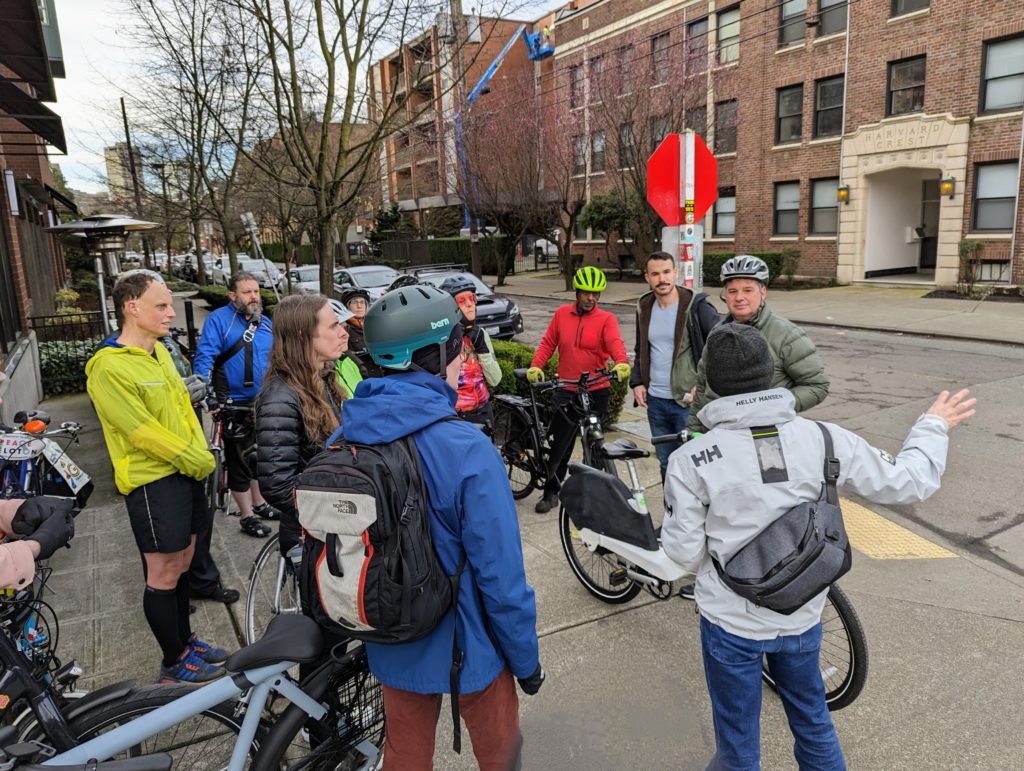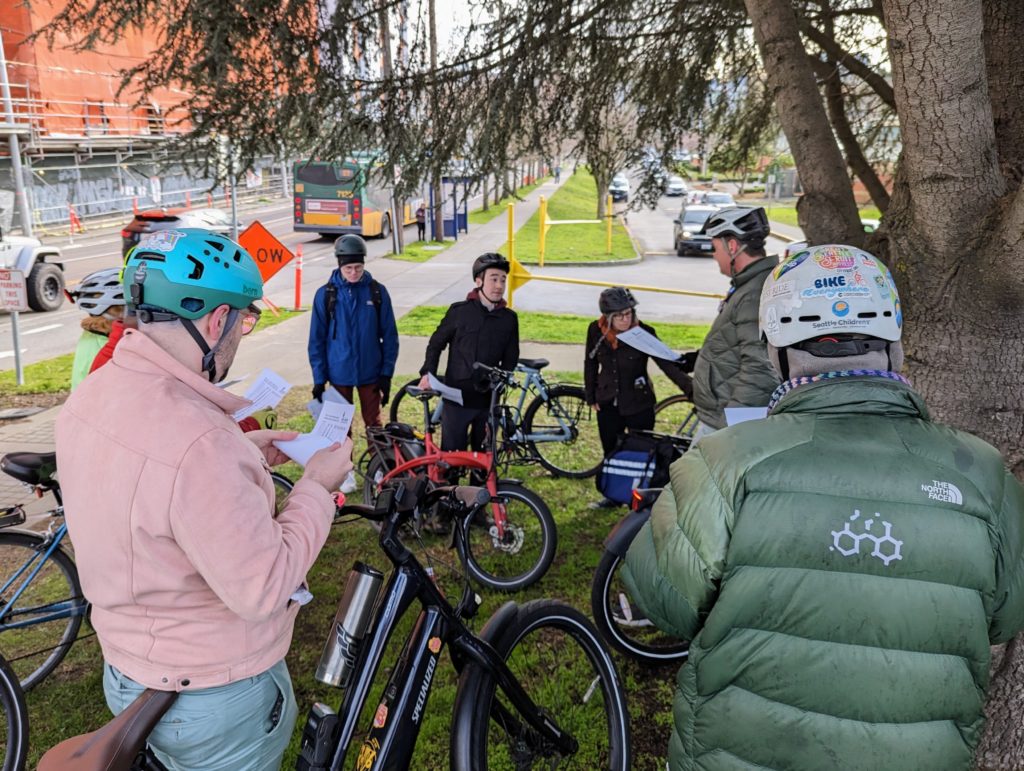In March, Central Seattle Greenways organized a listening tour with Seattle Department of Transportation (SDOT) Director Greg Spotts to share our work with him and illustrate some of the roadway challenges and opportunities that we’re focused on. Spotts has been attending listening tours with communities around Seattle since his confirmation as SDOT director in September 2022, and we appreciate his interest in working with us to envision safer and more accessible street infrastructure in Capitol Hill and the Central District.
Our tour began with a walk to Olive Way and Harvard Ave E, the site of a guerrilla crosswalk painted by frustrated community members in November 2022. Spotts informed us that improvements will be coming to that intersection in the short term. We spoke about the need for safety improvements along the entire Olive Way corridor, a popular and logical walking route from downtown and South Lake Union to Capitol Hill that nonetheless continues to prioritize vehicle traffic accessing I-5. CSG has formally asked SDOT to develop an Olive Way Corridor Plan for Olive Way between I-5 and Broadway, which would gather community input and guide future streetscape changes to slow vehicles.


We then biked along 12th Ave to Bailey Gatzert Elementary, where three busy arterials converge – 12th Ave, Boren Ave, and E Yesler Way. CSG has been working with Bailey Gatzert and volunteer parents over the past few years to implement Safe Routes to School practices, including a Walking School Bus (check out SDOT’s blog post for more info about this inspiring initiative). With support from SDOT, CSG will soon be engaging members of the surrounding communities in a visioning process about their transportation needs and the possibility of a long-term redesign of streets to improve mobility for all.
At Bailey Gatzert, we shared with Director Spotts our desire to see safety improvements made for people walking and biking along 12th Ave, a vital route that connects Capitol Hill, First Hill, the Central District, Chinatown-International District, and Beacon Hill. At present, 12th Ave is an incredibly uncomfortable and hazardous route, with few crosswalks in some sections and door-zone painted bike lanes that come and go. Our group’s preliminary research on collision and injury patterns along the corridor, which we shared with Spotts, found that over 300 people walking and biking have been hit and injured by cars along 12th Ave over the past decade. Our hope is that SDOT’s Vision Zero team can be empowered to create a comprehensive safety plan for 12th Ave, and that SDOT can find the funding to make it happen.


Afterwards, we biked back up 12th Ave to its intersection with E Madison St. Here, construction for the Madison BRT (RapidRide G) project has unfortunately created chaotic conditions for people walking and biking in many areas of the corridor at various times. We expressed our frustration that the SDOT Director’s Rule requiring appropriate accommodations for people biking and walking is so often ignored and rarely enforced during both private and public construction projects. Ideally, the Director’s Rule would be enforced and strengthened, and detour planning for people walking and biking would be better integrated into early project planning phases and informed by the expertise of SDOT’s pedestrian and bicycle planners.

Our tour concluded at Melrose Ave and E Pike St, where the current design under the Pike Pine Streetscape & Bicycle Improvements Project (a part of the Pike Pine Renaissance Project) diverts westbound (downhill) bicyclists traveling on E Pike St north onto Melrose Ave to access a future westbound protected bike lane on E Pine St. As the diagram above illustrates, this design requires people traveling eastbound (uphill) on bikes to make a two-stage turn through a small bike box to cross from the left side to the right side of the street to continue up the hill. This creates a situation where many bicyclists may continue to choose to ignore the design and signals in order to preserve their momentum and find other, potentially risky, ways to cross. The bike box will also be too small for multiple people on bikes to use at once, especially if they’re riding cargo or family bikes. We’ve asked SDOT to work with the Office of the Waterfront to create a better design for transitioning cyclists at Melrose and Pike, preferably with a signal-supported diagonal crossing similar to the one at 8th and Virginia.
At Melrose and Pike, we also called attention to the poor design of the “raised” intersection constructed there as part of the Melrose Promenade project. Contrary to its intended status as a pedestrian-focused space, the design of this intersection does not communicate to drivers (many of whom use Melrose as a shortcut to access I-5) that they need to slow down and limit themselves to the red “brick” area if stopping. It’s common to see drivers using the sidewalk space for loading and unloading materials for the nearby business or ride share drivers picking up or dropping off passengers. For people walking and rolling, it is unclear whether it is safe or legal to cross anywhere in the raised portion of the intersection. Clearly there is a need for better visual cues for drivers and people loading and unloading as to how they should use the space. We shared specific ideas with Director Spotts about ways that SDOT could revise the intersection to make Melrose actually friendly to pedestrians, as the community intended going into the Melrose Promenade project.
After the listening tour, we followed up with a letter summarizing our main asks of SDOT. We thank Director Spotts and his department’s staff for engaging with us on our vision for a more bikeable and walkable neighborhood. If you’d like to get involved with these efforts, please join us! All are welcome to attend our monthly meetings. You can subscribe to Central Seattle Greenways’ email list here for updates and meeting agendas.

 RSS - Posts
RSS - Posts